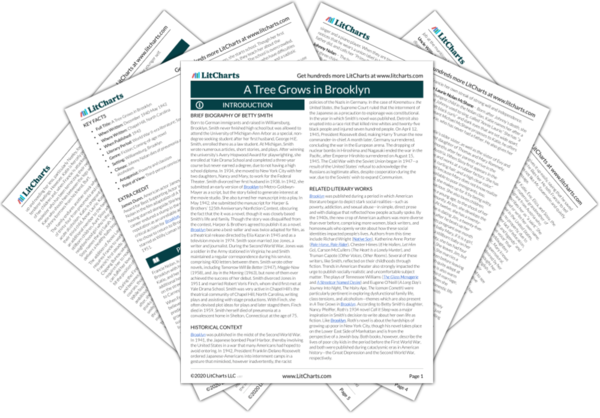Born to German immigrants and raised in Williamsburg, Brooklyn, Smith never finished high school but was allowed to attend the University of Michigan-Ann Arbor as a special, non-degree seeking student after her first husband, George H.E. Smith, enrolled there as a law student. At Michigan, Smith wrote numerous articles, short stories, and plays. After winning the university’s Avery Hopwood Award for playwrighting, she enrolled at Yale Drama School and completed a three-year course but never earned a degree, due to not having a high school diploma. In 1934, she moved to New York City with her two daughters, Nancy and Mary, to work for the Federal Theater. Smith divorced her first husband in 1938. In 1942, she submitted an early version of
Brooklyn to Metro-Goldwyn-Mayer as a script, but the story failed to generate interest at the movie studio. She also turned her manuscript into a play. In May 1942, she submitted the manuscript for Harper & Brothers’ 125th Anniversary Nonfiction Contest, obscuring the fact that the it was a novel, though it was closely based Smith’s life and family. Though the story was disqualified from the contest, Harper & Brothers agreed to publish it as a novel.
Brooklyn became a best-seller and was twice adapted for film, as a theatrical release directed by Elia Kazan in 1945 and as a television movie in 1974. Smith soon married Joe Jones, a writer and journalist. During the Second World War, Jones was a soldier in the Army stationed in Virginia; he and Smith maintained a regular correspondence during his service, comprising 400 letters between them. Smith wrote other novels, including
Tomorrow Will Be Better (1947),
Maggie-Now (1958), and
Joy in the Morning (1963), but none of them ever achieved the success of her debut. Smith divorced Jones in 1951 and married Robert Voris Finch, whom she’d first met at Yale Drama School. Smith was very active in Chapel Hill’s the theatrical community of Chapel Hill, North Carolina, writing plays and assisting with stage productions. With Finch, she often devised plot ideas for plays and later staged them. Finch died in 1959. Smith herself died of pneumonia at a convalescent home in Shelton, Connecticut at the age of 75.
